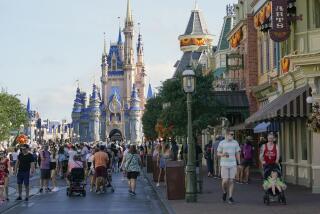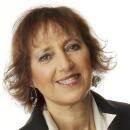SeaWorld unable to reverse continued attendance slide
- Share via
SeaWorld attendance and revenues fell sharply during the key summer months, with the San Diego and Orlando marine parks experiencing the brunt of poor visitation trends, the company reported Tuesday.
While the third quarter results for the Florida and Texas parks were clearly impacted by Hurricanes Irma and Harvey, which forced them to close temporarily, SeaWorld San Diego’s attendance woes had more to do with the “public perception” issues that have dogged it for the last several years, the company acknowledged.
Its falling attendance was fueled in part by fewer visitors from the Southern California area, the company said.
Companywide, attendance during the quarter ending Sept. 30 declined nearly 9 percent, with 732,000 fewer people visiting the theme parks compared with the same quarter a year earlier. Just a year ago, attendance during the third quarter had been flat.
Quarterly revenues also saw a steep drop last quarter, falling by 10 percent, to $437.7 million, SeaWorld Entertainment reported.
More precipitous was the fall in net profits — 16 percent — to $55 million from $65.7 million a year earlier.
The company’s poor showing comes on the heels of continued cost-cutting, which included the recent elimination of 350 positions. SeaWorld says it remains on track to reach its target of $40 million in net cost savings by the end of 2018. It also identified an additional $25 million in cost savings
In what has become a familiar refrain, SeaWorld CEO Joel Manby said he expects that new attractions, pricing promotions and aggressive marketing will help drive a turnaround. Zeroing in on San Diego, the park he said needs the most attention, Manby sought to put a positive spin on the disappointing quarterly results, pointing to an uptick in attendance in October.
“Our local attendance in San Diego is up double digits on a day to day basis in October and that’s the strongest increase we’ve had all year,” Manby told analysts during the earnings call. “I’m not using that to predict exact outcomes for the future, but we’re very encouraged because San Diego is the key park for us to turn, as well as Orlando.”
Manby credited a new local advertising campaign, “Park to Planet,” for helping drive the turnaround. “Park to Planet,” a feel-good commercial dominated by video of the ocean, marine mammals, rescue work and undersea exploration, began airing in San Diego last month and is expected to go nationwide next year.
The company had acknowledged in August that it had made a mistake in pulling back on advertising that was designed to bolster its brand. SeaWorld has been suffering for years from the backlash of the 2013 anti-captivity documentary “Blackfish” and believed that it had finally put its image troubles behind it.
“We’ve proven in 2017 we can turn a SeaWorld park in a positive direction,” Manby said of successful efforts to revive revenues and attendance at the San Antonio SeaWorld. “.And we intend with all of our effort and all of our energy to turn the other two SeaWorld parks around. Once we can show growth in 2018, it’s really clear this stock is undervalued in our mind.”
In early trading, SeaWorld stock was up by more than 6 percent, but by market close, the increase had dropped to 1.5 percent, or 17 cents, to close at $11.36. Over the last six months, the stock has sunk 37 percent.
Manby, when asked by an analyst about persistent rumors that the company may be up for sale, declined to comment.
People for the Ethical Treatment of Animals used the occasion of the earnings report to once again call on SeaWorld to retire its captive orcas to seaside pens. Early last year, Manby announced that the company would no longer breed its killer whales.
“If this abusement park wants to improve its earnings reports, it must overhaul its business model, release the surviving animals into coastal sanctuaries, and commit to earning the public’s forgiveness for the cruelty that it has committed,” PETA Executive Vice President Tracy Reiman said in a statement.
Wall Street analyst Tuna Amobi said that while he is encouraged by some of the positive steps SeaWorld is taking, like stepping up marketing and trimming expenses, daunting challenges remain.
“The main challenge next year is to mitigate the negative perception that has resurfaced and forced them to increase marketing spending,” said Amobi, of CFRA. “It’s a company that’s really swimming against some major headwinds from the past and trying to reinvent itself for the future, and I’m not clear when that final turning point will occur.”
Meanwhile, the company has once again lowered its annual expectation for adjusted earnings before interest, taxes, depreciation, and amortization, this time to a range of $280 million to $295 million. That is down from guidance of $280 million to $310 million announced just three months ago and an even earlier forecast of $330 million to $360 million.
The biggest factor in the decision to lower expectations was the $7 million hit the company took from the hurricanes. There were 26 days of park closures during the third quarter, more than double the 10 days parks were closed during the same period in 2016, SeaWorld said.
Company officials said the biggest attendance problems revolved around declines in international visitors — notably from the United Kingdom and Latin America — and domestic visitors coming from more than 300 miles away.
In a move to entice more Southern Californians to patronize SeaWorld, the San Diego park began promoting a discounted $99.99 annual pass that includes free parking, which Manby said has proven to be very popular.
SeaWorld San Diego is hoping attendance will also get a much-needed boost next year from the planned opening of the park’s fastest and tallest roller coaster, the Electric Eel.
Business
lori.weisberg@sduniontribune.com
(619) 293-2251
Twitter: @loriweisberg
More to Read
Inside the business of entertainment
The Wide Shot brings you news, analysis and insights on everything from streaming wars to production — and what it all means for the future.
You may occasionally receive promotional content from the Los Angeles Times.











